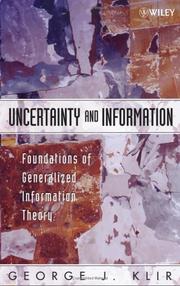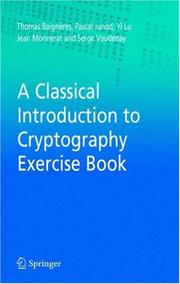| Listing 1 - 3 of 3 |
Sort by
|

ISBN: 012620862X 9780126208627 9786611227319 1281227315 0080509258 9780080509259 9781281227317 6611227318 Year: 2006 Publisher: Amsterdam Boston Elsevier
Abstract | Keywords | Export | Availability | Bookmark
 Loading...
Loading...Choose an application
- Reference Manager
- EndNote
- RefWorks (Direct export to RefWorks)
Each edition of Introduction to Data Compression has widely been considered the best introduction and reference text on the art and science of data compression, and the third edition continues in this tradition. Data compression techniques and technology are ever-evolving with new applications in image, speech, text, audio, and video. The third edition includes all the cutting edge updates the reader will need during the work day and in class. Khalid Sayood provides an extensive introduction to the theory underlying today's compression techniques with detailed instruction for their app
Coding theory --- Data compression (Telecommunication) --- 681.3*E4 --- Compression of data (Telecommunication) --- Data compression (Computer science) --- Data transmission systems --- Digital electronics --- Information theory --- Machine theory --- Signal theory (Telecommunication) --- Computer programming --- 681.3*E4 Coding and information theory: data compaction and compression; formal modelsof communication; nonsecret encoding schemes--See also {681.3*H11} --- Coding and information theory: data compaction and compression; formal modelsof communication; nonsecret encoding schemes--See also {681.3*H11} --- Coding theory.

ISBN: 9780471748670 0471748676 9780471755579 0471755575 1280242981 9786610242986 0470315741 0471755567 Year: 2006 Publisher: Hoboken, New Jersey [Piscataqay, New Jersey] Wiley-Interscience IEEE Xplore
Abstract | Keywords | Export | Availability | Bookmark
 Loading...
Loading...Choose an application
- Reference Manager
- EndNote
- RefWorks (Direct export to RefWorks)
Deal with information and uncertainty properly and efficiently using tools emerging from generalized information theory Uncertainty and Information: Foundations of Generalized Information Theory contains comprehensive and up-to-date coverage of results that have emerged from a research program begun by the author in the early 1990s under the name "generalized information theory" (GIT). This ongoing research program aims to develop a formal mathematical treatment of the interrelated concepts of uncertainty and information in all their varieties. In GIT, as in classical information theory, uncertainty (predictive, retrodictive, diagnostic, prescriptive, and the like) is viewed as a manifestation of information deficiency, while information is viewed as anything capable of reducing the uncertainty. A broad conceptual framework for GIT is obtained by expanding the formalized language of classical set theory to include more expressive formalized languages based on fuzzy sets of various types, and by expanding classical theory of additive measures to include more expressive non-additive measures of various types. This landmark book examines each of several theories for dealing with particular types of uncertainty at the following four levels: * Mathematical formalization of the conceived type of uncertainty * Calculus for manipulating this particular type of uncertainty * Justifiable ways of measuring the amount of uncertainty in any situation formalizable in the theory * Methodological aspects of the theory With extensive use of examples and illustrations to clarify complex material and demonstrate practical applications, generous historical and bibliographical notes, end-of-chapter exercises to test readers' newfound knowledge, glossaries, and an Instructor's Manual, this is an excellent graduate-level textbook, as well as an outstanding reference for researchers and practitioners who deal with the various problems involving uncertainty and information. An Instructor's Manual presenting detailed solutions to all the problems in the book is available from the Wiley editorial department.
Uncertainty (Information theory) --- Fuzzy systems --- Incertitude (Théorie de l'information) --- Systèmes flous --- 519.72 --- 681.3*E4 --- Information theory: mathematical aspects --- Coding and information theory: data compaction and compression; formal modelsof communication; nonsecret encoding schemes--See also {681.3*H11} --- 681.3*E4 Coding and information theory: data compaction and compression; formal modelsof communication; nonsecret encoding schemes--See also {681.3*H11} --- 519.72 Information theory: mathematical aspects --- Incertitude (Théorie de l'information) --- Systèmes flous --- Measure of uncertainty (Information theory) --- Shannon's measure of uncertainty --- System uncertainty --- Information measurement --- Probabilities --- Questions and answers --- Systems, Fuzzy --- System analysis --- Fuzzy logic --- Fuzzy systems.


ISBN: 9780387279343 9780387288352 0387279342 038728835X 9786610969425 1280969423 Year: 2006 Publisher: Boston, MA Springer Science+Business Media, Inc.
Abstract | Keywords | Export | Availability | Bookmark
 Loading...
Loading...Choose an application
- Reference Manager
- EndNote
- RefWorks (Direct export to RefWorks)
This companion exercise and solution book to A Classical Introduction to Cryptography: Applications for Communications Security contains a carefully revised version of teaching material. It was used by the authors or given as examinations to undergraduate and graduate-level students of the Cryptography and Security Lecture at EPFL from 2000 to mid-2005. A Classical Introduction to Cryptography Exercise Book for A Classical Introduction to Cryptography: Applications for Communications Security covers a majority of the subjects that make up today's cryptology, such as symmetric or public-key cryptography, cryptographic protocols, design, cryptanalysis, and implementation of cryptosystems. Exercises do not require a large background in mathematics, since the most important notions are introduced and discussed in many of the exercises. The authors expect the readers to be comfortable with basic facts of discrete probability theory, discrete mathematics, calculus, algebra, as well as computer science. Following the model of A Classical Introduction to Cryptography: Applications for Communications Security, exercises related to the more advanced parts of the textbook are marked with a star.
Computer security --- Cryptography --- 681.3*E1 --- 681.3*E3 --- 681.3*E4 --- Cryptanalysis --- Cryptology --- Secret writing --- Steganography --- Signs and symbols --- Symbolism --- Writing --- Ciphers --- Data encryption (Computer science) --- Computer privacy --- Computer system security --- Computer systems --- Computers --- Cyber security --- Cybersecurity --- Electronic digital computers --- Protection of computer systems --- Security of computer systems --- Data protection --- Security systems --- Hacking --- 681.3*E3 Data encryption: data encryption standard; DES; public key cryptosystems --- Data encryption: data encryption standard; DES; public key cryptosystems --- 681.3*E1 Data structures: arrays; graphs; lists; tables; trees --- Data structures: arrays; graphs; lists; tables; trees --- 681.3*E4 Coding and information theory: data compaction and compression; formal modelsof communication; nonsecret encoding schemes--See also {681.3*H11} --- Coding and information theory: data compaction and compression; formal modelsof communication; nonsecret encoding schemes--See also {681.3*H11} --- Protection --- Security measures --- Computer security. --- Cryptography. --- Sécurité informatique --- Cryptographie --- Problems, exercises, etc. --- Problèmes et exercices --- EPUB-LIV-FT LIVINFOR SPRINGER-B --- Data encryption (Computer science). --- Information theory. --- Computer Communication Networks. --- Data structures (Computer science) --- Coding theory. --- Data transmission systems. --- Cryptology. --- Theory of Computation. --- Data Structures and Information Theory. --- Coding and Information Theory. --- Input/Output and Data Communications. --- Information structures (Computer science) --- Structures, Data (Computer science) --- Structures, Information (Computer science) --- Electronic data processing --- File organization (Computer science) --- Abstract data types (Computer science) --- Data communication systems --- Transmission of data --- Digital communications --- Electronic systems --- Information theory --- Telecommunication systems --- Data compression (Telecommunication) --- Digital electronics --- Machine theory --- Signal theory (Telecommunication) --- Computer programming --- Communication theory --- Communication --- Cybernetics --- Data encoding (Computer science) --- Encryption of data (Computer science) --- Computers. --- Computer communication systems. --- Data structures (Computer science). --- Input-output equipment (Computers). --- Computer hardware --- Computer I/O equipment --- Electronic analog computers --- Hardware, Computer --- I/O equipment (Computers) --- Input equipment (Computers) --- Input-output equipment (Computers) --- Output equipment (Computers) --- Communication systems, Computer --- Computer communication systems --- Data networks, Computer --- ECNs (Electronic communication networks) --- Electronic communication networks --- Networks, Computer --- Teleprocessing networks --- Data transmission systems --- Information networks --- Telecommunication --- Cyberinfrastructure --- Network computers --- Automatic computers --- Automatic data processors --- Computing machines (Computers) --- Electronic brains --- Electronic calculating-machines --- Electronic computers --- Calculators --- Cyberspace --- Input-output equipment --- Distributed processing
| Listing 1 - 3 of 3 |
Sort by
|

 Search
Search Feedback
Feedback About UniCat
About UniCat  Help
Help News
News